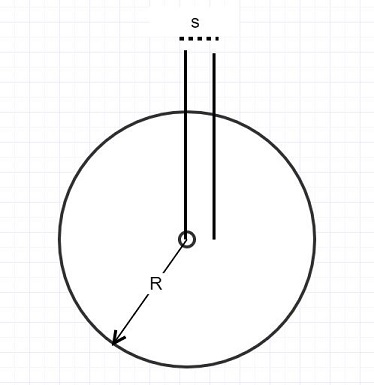Field of a Charged Ball
By Eric Erwood Claimed by Andrea Diaz (Fall 2016) Claimed by Jordan Bethea (Spring 2017)
In this section, we will discuss the electric field of a charged ball. Such a sphere has charge distributed throughout the volume (rather than only on the surface), and can be modeled by several layers of concentric, charged spherical shells.
The Main Idea
In this section, we will focus on a scenario where a ball has charge distributed throughout its volume. Calculating the electric field both outside and inside the sphere will be addressed.
A Mathematical Model
Step 1: Given a solid charged sphere throughout its volume, the first step is to cut up the the sphere into pieces. As a result, the solid sphere will appear as a series of spherical shells.
Step 2: Relationship between r and R. Next, it is necessary to determine whether the observation point is outside or inside the sphere.
If r>R, then we are outside the sphere. All the spherical shells appear as point charges at the center of the sphere. As a result, the electric field outside the sphere is a point charge:
[math]\displaystyle{ \vec E=\frac{1}{4 \pi \epsilon_0}\frac{Q}{r^2} \hat r }[/math] when r>R, and R is the radius of the sphere.
However, when r<R, the observation location is inside some of the shells but outside others. To find [math]\displaystyle{ \vec E_{net} }[/math], add the contributions to the electric field from the inner shells. After adding the contributions of each inner shell, you should have an electric field equal to:
[math]\displaystyle{ \vec E = \frac{1}{4 \pi \epsilon_0}\frac{\Delta Q}{r^2} }[/math]
We find [math]\displaystyle{ \Delta Q }[/math]:
[math]\displaystyle{ \Delta Q = Q \frac{\text {volume of inner shells}}{\text {volume of sphere}} = Q \frac{\frac{4}{3} \pi r^3}{\frac{4}{3} \pi R^3} }[/math]
We find that:
[math]\displaystyle{ \vec E = \frac{1}{4 \pi \epsilon_0}\frac{Q}{r^2}\frac{\frac{4}{3} \pi r^3}{\frac{4}{3} \pi R^3} = \frac{1}{4 \pi \epsilon_0}\frac{Q}{R^3}r }[/math]
The charge inside the sphere is proportional to r. When r=R,
[math]\displaystyle{ \vec E = \frac{1}{4 \pi \epsilon_0}\frac{Q}{R^2} }[/math]
A Computational Model
https://trinket.io/glowscript/48f6efd07a
use this code to see how it looks, change the r value.
Examples
Simple
1. Describe the pattern of the electric field of charged ball from far away.
ANS: If we observe a charged ball from far away, we can say that r>R. Because we are outside of the sphere, the ball can essentially be viewed as a point charge. Thus the electric field can be defined by: [math]\displaystyle{ \vec E=\frac{1}{4 \pi \epsilon_0}\frac{Q}{r^2} \hat r }[/math]
Middling
A sphere is charged throughout it's volume with a charge of Q= 6e-5 C. The radius of the this sphere is R=10. Find the electric field created by a sphere of radius r=4.
Step 1: cut up the sphere into shells
step 2: we know that r<R
Next find [math]\displaystyle{ \Delta Q }[/math]:
[math]\displaystyle{ \Delta Q = Q \frac{\text {volume of inner shells}}{\text {volume of sphere}} = Q \frac{\frac{4}{3} \pi r^3}{\frac{4}{3} \pi R^3} }[/math]
[math]\displaystyle{ \vec E = \frac{1}{4 \pi \epsilon_0}\frac{Q}{r^2}\frac{\frac{4}{3} \pi r^3}{\frac{4}{3} \pi R^3} = \frac{1}{4 \pi \epsilon_0}\frac{Q}{R^3}r }[/math]
[math]\displaystyle{ \vec E = \frac{1}{4 \pi \epsilon_0}\frac{Q}{R^3}r = 9e9 * \frac{6*10^{-5} C}{(10m)^3}*4m = 2160 N/C }[/math]
Difficult
A simplified model of a hydrogen atom is that the electron cloud is a sphere of radius R with uniform charge density and total charge −e. (The actual charge density in the ground state is nonuniform.)
For the uniform-density model, calculate the polarizability α of atomic hydrogen in terms of R. Consider the case where the magnitude E of the applied electric field is much smaller than the electric field required to ionize the atom. Suggestions for your analysis: Imagine that the hydrogen atom is inside a capacitor whose uniform field polarizes but does not accelerate the atom. Consider forces on the proton in the equilibrium situation, where the proton is displaced a distance s from the center of the electron cloud
(s « R in the diagram). (Use the following as necessary: R and ε0.)
Useful equations:
[math]\displaystyle{ \vec p = \alpha *E }[/math]
[math]\displaystyle{ \vec p = Q*s }[/math]
Assume an applied electric field of strength E. This electric field polarized the hydrogen atom. Now there is a spherical charge of radius s. Use the volume ratio, and then use the useful equations to find [math]\displaystyle{ \alpha }[/math]
[math]\displaystyle{ \vec E = \frac{1}{4 \pi \epsilon_0}\frac{e}{s^2}\frac{\frac{4}{3} \pi s^3}{\frac{4}{3} \pi R^3} = \frac{1}{4 \pi \epsilon_0}\frac{e}{R^3}s }[/math]
[math]\displaystyle{ \alpha = \frac{e*s}{\frac{1}{4 \pi \epsilon_0}\frac{e}{R^3}s} = 4\pi \epsilon_0 R^3 }[/math]
Looking Ahead, Gauss's Law
Later in this wikibook, you will learn about Gauss's Law. This will make calculating the electric field easier.
The formula for Gauss's Law is:
[math]\displaystyle{ \oint \vec E \bullet \hat n dA = \frac{1}{\epsilon_0}\Sigma Q_{\text {inside the surface}} }[/math]
Using this, one can calculate the the electric field when r<R for a solid sphere charged throughout.
[math]\displaystyle{ \vec E * 4\pi*r^2= \frac{1}{\epsilon_0}Q\frac{\frac{4}{3} \pi r^3}{\frac{4}{3} \pi R^3} }[/math]
[math]\displaystyle{ \vec E = \frac{1}{4 \pi \epsilon_0}\frac{Q}{R^3}r }[/math]
Connectedness
It may be particularly useful to discuss real-life applications of a charged solid sphere. Two examples stem from the structure of an atom. The nucleus of an atom is packed very tightly so that we can consider the charge to be uniformly distributed. The electron cloud also can be viewed as a packed spherical region of charged. Of course the radii of these structures are very small; radii are about 10e-15 m and 10e-10 m for nuclei and electron clouds respectively!
See also
Further reading
http://www.physicsbook.gatech.edu/Point_Charge
http://www.physicsbook.gatech.edu/Electric_Dipole
http://www.physicsbook.gatech.edu/Gauss%27s_Flux_Theorem
References
This section contains the the references you used while writing this page
http://hyperphysics.phy-astr.gsu.edu/hbase/electric/elesph.html
Matter and Interactions, 4th Edition: 1-2
